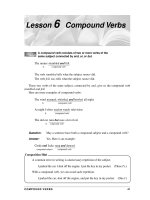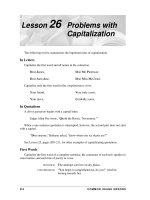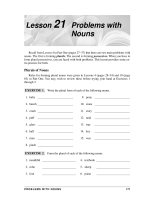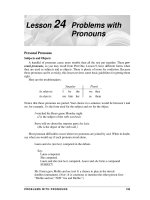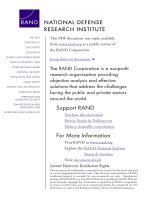Support Materials and Exercises for WRITING LETTERS docx
Bạn đang xem bản rút gọn của tài liệu. Xem và tải ngay bản đầy đủ của tài liệu tại đây (407.18 KB, 65 trang )
ACADEMIC STUDIES
ENGLISH
Support Materials and Exercises
for
WRITING LETTERS
WINTER 1999
WRITING LETTERS
ACADEMIC ENGLISH
ACKNOWLEDGEMENTS
The following persons have contributed to the development of this learning material:
Content and Structure:
Curriculum Developer(s)
Leslie Childs English Curriculum Content Expert
New Brunswick Community College Bathurst
Project Supervision/Co-ordination:
Angela Acott-Smith Project Co-ordinator
New Brunswick Community College Woodstock
Kay Curtis Literacy Co-ordinator
New Brunswick Community College Woodstock
This document is available full-text on the World Wide Web thanks to
the National Adult Literacy Database.
/>The financial support for this learning materials project was provided by
the National Literacy Secretariat of Human Resources Development Canada.
Winter 1999
This support module may be used with BAU-ENG 6.9, Letters, and IAU-ENG 2.7,
Writing Letters.
BAU-ENG 6.9 LETTERS
OBJECTIVE
Upon successful completion of this unit, the learner will be able to
1. compose a friendly/informal letter.
2. prepare a letter for mailing.
TEACHING POINTS Level
Format
1 salutation, body, closing 5/6
2 correct punctuation of parts of the friendly/informal letter 5/6
Mailing
3 fold letter correctly 5/6
4 correct format for address 5/6
5 correct postal codes: e.g. NB, ON, SK 5/6
6 correct format and placement of postal codes 5/6
7 size of envelope 5/6
8 return address 5/6
Uses
9 to correspond with friend 5/6
10 letter to the teacher 5/6
11 letter to “Dear Abby” 5/6
12 informal invitation, letter of regret, letter of condolence 5/6
Learners should be encouraged to write “real” letters wherever possible in this module. In
addition, learners may take over the responsibility of writing letters associated with the day to
day activities of the class, e.g. inviting and thanking speakers, thanking donors, etc.
IAU-ENG 2.9 WRITING LETTERS
OBJECTIVE
Upon successful completion of this unit, the learner will be able to
1. plan and write friendly and formal letters.
2. plan and write business letters.
3. prepare letters for mailing.
TEACHING POINTS Level
Personal
Letters
1 Parts: date, salutation, body, closing 7
2 Appropriate content 7
Envelopes
3 Correct address position and format 7
4 Return address 7
5 Folding and inserting letter correctly 7
Business
Letters
6 Parts: return and inside address, salutation, body, closing 8
7 Types: request 8
8 inquiry 8
9 order 8
10 complaint 8
11 Format: full block 8
12 block (sometimes called modified block) 8
13 modified block (sometimes called modified with indents 8
14 Structure: 1 paragraph-general statement 8
st
15 2 paragraph-specific details 8
nd
16 3 paragraph-specific request 8
rd
17 Special Parts: subject line 9
18 copy line 9
19 enclosure line 9
20 typist’s identification 9
NOTE TO FACILITATORS AND LEARNERS:
1. This module, Writing Letters, presents information and exercises to accompany the
objectives of BAU-ENG 6.9, Letters, and IAU-ENG 2.7, Writing Letters.
2. Learners working to complete the requirements of BAU-ENG should complete all the
sections on PERSONAL LETTERS plus the section on ENVELOPES located on page
42.
3. Learners working to complete the requirements of IAU-ENG should review the section on
PERSONAL LETTERS before starting work on BUSINESS LETTERS.
4. Facilitators are free to use any support materials appropriate to their learners’ needs.
5. Additional resource materials will probably be required for those wanting more
information on this topic or for those needing more practice mastering certain areas. Any
text on writing can provide additional useful material.
6. Alternate support materials may be appropriate.
7. Some confusion may arise from the names of the three business letter formats. Different
texts use different names and some are contradictory. Learners should know how to
recognize each format according to its features.
8. Writing is always the best to learn how to write. Learners should be encouraged to write
“real” letters wherever possible in this module and actually send them. In addition,
learners should take the responsibility to write letters associated with the day to day
running of the class. e.g. letters to invite and thank speakers, letters requesting research
informations, etc.
9. It is the learner’s responsibility to search out additional exercises to supplement the
practice work included in this module by consulting with his/her facilitator.
11 Do NOT write in this module. Please make your notes and complete the exercises in your
own notebooks so that other learners may also use these booklets.
TABLE OF CONTENTS
INTRODUCTION 1
PERSONAL LETTERS 2
Types of Personal Letters 5
Folding Letters 14/ 15
BUSINESS LETTERS 17
Essential Parts of a Business Letter 18
Business Letter Formats 21
The Body of a Business Letter 26
Types of Business Letters 26
Folding Business Letters 41
USING PRE-PRINTED LETTERHEAD 25
PUNCTUATION STYLES 25
ADDRESSING ENVELOPES 42
BAU ENG PRE-TEST 49
IAU ENG PRE-TEST 50
ANSWER KEY FOR IAU ENG PRE-TEST 53
FEEDBACK FORM 58
1
I. INTRODUCTION
In this module on letter writing, you will have an opportunity to investigate a
special kind of writing that is particularly useful in your everyday life, at home and
at work. To create an effective letter, writer needs three sets of skills:
10. A good knowledge of mechanics (spelling, grammar, etc.)
11. The ability to structure good sentences and paragraphs
12. A familiarity with the conventions readers have come to expect
when reading letters.
You have already had a lot of practice with the first two
skills. The only one left to master is the conventions
(arrangement of details) within the letter.
People communicate every day by telephone,
computer e-mail, the Internet, and that modern marvel,
the "fax" machine, where an exact copy of any document
is transferred thousands of miles over telephone cables.
Does anyone still write letters?
The answer is a strong and definite, yes. Letter writing is still important. It is
sometimes easier to write down our feelings and thoughts than it is to speak them.
It also remains less expensive to mail a letter to family or friends than to call long
distance or pay for access to a computer and e-mail. For conducting personal
business, such as requesting services from a company, complaining about products,
applying for employment, and contacting the editor of a local newspaper, letters
remain the best and most effective way of getting the message across.
Letters, unlike phone calls, have several advantages. First, they provide a
permanent record of what was said. Second, the writer has the time to carefully
compose the message, and the reader has the time to read it and reread it until the
message is clear. As well, a letter can be kept on file and used as many times as
necessary. Other forms of communication may not offer this advantage.
In the business world, letter writing continues to play a vital role. Letters
flow regularly between offices, companies, and other organizations.
Anyone can write a letter; however, it is important to learn how to write an
effective letter, one that ensures that you will get what you want. You need to be
taken seriously. You need to make yourself understood.
Certain styles of letters are required for certain occasions. When deciding
what style of letter to write, consider the purpose of the letter, and the audience of
the letter. If you are writing to a friend about your new job, for example, you would
2
write a personal letter. If you are writing to a car dealership to complain about the
number of times you had your car serviced, you would write a business letter.
A. PERSONAL LETTERS
A personal letter is written to someone you know or want to know better. A
personal letter is usually written in casual, friendly language, or in practical
straightforward language, depending on the purpose and audience of the letter.
1. PARTS OF THE PERSONAL LETTER
All letters must follow certain conventions or formats. Here is the format to
use when writing a personal letter. It will help you organize your letter and make it
easier for your friend to read. The personal letter format has five parts.
Heading/Date
Salutation,
Body
Complimentary closing,
Signature
1. The Heading
The heading may include your complete address, but it certainly must have
the date. It is placed in the upper right hand corner of the letter. If you choose to
include your own address, set it up this way. On the first line, write your apartment
number, postal box, rural route number, and your street address (whatever applies to
your address). The second line should list your city, town, or village, the province,
and postal code. (Do not use a dash between the two sections of your postal code.)
The third line gives the month, the day and the year you are writing the letter.
3
129 Croydon Drive
Westbrook, NB E3M 7B7
July 25, 1999
129 Croyden Drive
Westbrook , NB E3M 7B7
July 25, 20
Hi Pat,
Never write your name as any part of the heading. An example of a heading
follows.
If you choose not to include your return address, simply write the date at the
top right of the page.
2. The Salutation
The salutation is the greeting you send to the reader. It is up to you how you
address your friend - remember, a personal letter is written in casual language.
Often, the salutation begins "Dear ," although other greetings, such as "Hello, ,"
or "Hi, " are acceptable.
The salutation is written two lines below the heading, at the left margin. A
comma usually follows the salutation in a personal letter.
4
129 Croydon Drive
Westbrook, NB E3M 7B7
July 25, 20
Hi Pat,
______________________________________________________
__________________________________________________________
___________________.
__________________BODY______________________________
__________.
COMPLIMENTARY CLOSINGö Your friend,
3. The Body of the Letter
In the body of a personal letter you do your "talking." The message you place
in the body should follow all the basic rules of paragraphing, spelling, punctuation,
sentence structure and paragraphing. Indent the first line of each new paragraph
about five spaces. Again, the language should be casual. The details you include,
and the order in which you present them, depend on you and what you want to say.
4. The Complimentary Closing
The closing is like saying good-bye. Capitalize only the first word of your
closing. Punctuate it at the end with a comma. Common closings are, “Yours
truly,” “Love,” and “Your friend,”. The closing should be placed to the right of the
centre line of the letter. Line up the first word of your closing with the first word in
your heading.
5. The Signature
The signature is the part of the letter where you sign your name. You may
sign with your first name only, if the person receiving the letter would recognize you
from just your first name. Otherwise, use your full name. Sign your name beneath
the closing; the first letter of your name should line up with the first letter of the
5
Your friend,
Donna Wilson
closing.
2. TYPES OF PERSONAL LETTERS
Any time you write a letter for a personal reason, you may use a personal
letter format. This module includes samples of six types of personal letters.
a. FRIENDLY LETTERS
When you write to a friend to exchange news and “catch-up” on the latest
news, the letter is written in casual language. You write as if you were speaking to
the friend. Although the letter may be to someone who knows you well, it is
important that you spell correctly, write in complete sentences, and keep your
thoughts separate by writing in complete sentences and paragraphs, indenting at the
beginning of each paragraph. Grammar, spelling, capitalization, and punctuation
count as well. You want the reader to understand what you mean to say.
It is up to you what kind of paper you wish to use to write your letter.
Obviously, a crudely torn-out sheet of tablet paper, or writing in the margins of a
newspaper will not do! Use paper that is clean and neat. Unlined paper is
considered most proper. White, cream, and light blue are probably the best colour
choices.
Neatness counts! It is the way you write your letter on the paper of your
choice that matters most. Try to keep your margins straight and even, so the reader
can easily follow what you are saying. Use pen, with blue or black ink. Pencil
smudges easily, and some coloured ink does not show up well. Try not to cross out
words, or smudge the ink. Use your best handwriting. If the reader cannot make
out your words, it does not matter what you say! If you are concerned that your
lines will be crooked, place a piece of lined paper under your blank page. The lines
will show through as you write, but, of course, will magically disappear when you
lift the paper you have written on
You may type longer letters, but only if you type well. It is difficult to correct
errors on some typewriters, especially if you find the errors after you have removed
the paper from the typewriter. Word processing, or typing on a computer, is
certainly acceptable. Be sure to proofread your work for typing errors. If you are
6
using a computer, you can use the spell and/or grammar checker.
Here are some guidelines for writing friendly letters.
1. If you are answering a letter you received from someone, thank the sender for
his/her letter, or for responding to questions you asked in your last letter. This
lets the reader know you received and read his/her letter.
2. If you are responding to a letter, have that letter on hand when you write your
reply. Answer the questions and comment on the information given in that letter.
This lets the reader know you were interested in what he or she had to say.
3. Write about things which would interest both you and the reader.
4. Make your letter as detailed and descriptive as possible. You want the reader
to be interested and to feel as if they have shared your experiences.
5. Ask questions so that your friend will have something to write back about.
Avoid filling your letter with questions, however. Your friend is probably
interested in what you are doing.
6. ALWAYS USE CORRECT SENTENCES AND PARAGRAPHS.
7. Proofread your letter for errors in expressions, as well as grammar. This will
help you reader and prevent misunderstandings.
On the next page, you can read an example of a friendly letter written in casual
language.
7
21 Price Street
Perth, Alberta
T1J 3X8
June 10, 20
Dear Jill,
I was very happy to hear from you so
soon. The pictures that you included from
Florida made me jealous! Here, it has been
like winter all the month of May.
As you may have noticed from my
address, I have big news for you! On May
28th, I joined the Welder's Union and within
three days they assigned me to a project in
Perth, Alberta. The address above is where I
now live. Things certainly change fast! So far,
I like the job. I have heard rumours that we
may be sent to the Yukon to work on contract.
While I am not thrilled about the climate
there, I would make much more money.
The only other item of news lately is that
my sister, Linda, is getting married this
summer. You will be receiving a wedding
invitation. She hasn't even made her mind up
8
Exercise I
NOTE: Please use unlined, white paper for this
exercise. It may be helpful to place a lined
sheet of paper beneath the unlined sheet, so
that you can write straight lines. Your
instructor will correct your work and record
your mark.
If possible, these letters should be real letters sent to real people. Sending and
receiving letters can be a great experience. Some friends have maintained a
correspondence for twenty years and more without ever having seen the other
person face to face in all that time.
It is alright, however, to use your imagination for this letter. The information given
does not have to be true, and the letter does not need to be sent to anyone.
1. Write a letter to a friend or relative in which you up-date him/her on the
events in your life over the past three months. Be sure to follow the
guidelines, format, and suggestions for writing friendly letters. Remember
that all spelling, grammar, and all the other conventions of standard English
usage apply, so always proofread your work.
2. Write a letter to a friend who has recently moved to another city. Again, be
sure to follow the guidelines, format, and suggestions for writing friendly
letters.
b. THANK-YOU NOTES
Thank-you notes, another type of personal letter, are sent as a courtesy to
thank someone for his or her thoughtfulness or kindness. After receiving a gift,
flowers, or a favour, sending a thank-you note lets the sender know you received
the gift, noticed the favour, or appreciated his/her kindness. The thank-you note
should be sent as soon as possible after receiving the gift or favour. Thank-you
notes follow the same format as friendly letters and in general should be
handwritten. Depending on who will receive the letter, you may use decorative note
paper. A sample thank-you note follows:
9
403 West Seventh
Street
St. Leonard, NB E3B
3W9
July 12, 20
Dear Laura and Stan,
We had a great time at your cottage last
weekend. Two whole days
of rest and good company beside the ocean did
wonders for both of us!
It certainly was good to catch up on what you’ve been
doing, and the food
was fantastic.
Thanks for giving us such a good time. We’re
looking forward to
seeing you in September at our camp for some
fishing.
Your friends,
Pauline and Daryl
Note the margins left around the outside of the letter. At least an inch should
be left all around the text of the letter.
10
RR 4, Site 23, Box 19
Chipman, NB E7N 3T6
July 25, 20
Dear Jack,
I heard only yesterday about Patty’s accident. I
want to express my
deep sympathy to you and your family on her death.
There is no way that
I can say in words how I feel, but I hope you know how
shocked and sad
I was when I heard the news. Patty was a very good
friend, and I will
never forget her. She was a generous woman who was
always there for me.
I will miss her very much, as will all of us here who
knew her.
Sincerely,
Lucy
c. LETTERS OF CONDOLENCE
Another type of personal letter, a letter of condolence, is sent to express
sympathy for something that has happened to the reader of the letter or to someone
close to him/her. This is probably the most difficult of all personal letters to write.
You will want to console the reader without increasing his/her sorrow. When
writing letters of condolence, start by telling why you are writing the letter. Then,
tell how you feel about the situation. Express your sympathy. Keep the letter as
simple as possible.
A letter of condolence follows:
11
November 2, 1999
Dear Mrs. Fairweather,
Jason was absent from school all last week, November
26 - 30 with a fever
and a cough. He is feeling much better now so he is
returning today at noon.
Would you please be sure that he has all the homework he
needs to catch up with the class before he leaves school
today.
Thank you.
Yours truly,
Angie Butterworth
d. NOTE TO THE TEACHER
Sometimes it is necessary to write a note to the school, to your child’s teacher
or to someone else in the community. The friendly letter format is also appropriate
in these situations. Here is a sample note to the teacher.
e. LETTERS OF INVITATION
When writing letters of invitation, you need to take special care to think about
your purpose in writing. For example, are you writing simply to invite them? Do
they need to be persuaded to come? Do you need to know for sure that they are
coming so you can make sure there will be enough food? Will they need a place to
sleep? Depending on the situation, they (your audience) may need very precise
information: exact location, exact time, appropriate dress, approximate costs, and
even sometimes whether it is necessary to reply to the invitation.
12
25 Albion Road
Moncton, NB E2C 3Y9
April 26, 2003
Dear Anna and Frank,
Next month on May 26, Mom and Dad are
celebrating their 50th wedding anniversary. We’ve
planned a homecoming weekend and invited family and
friends. We’d like you to be part of the celebration
because we know how close you were to them during the
time that you lived in Thamesville.
Organized activities start with a supper and
baseball game on Friday, May 26, at the church hall in
Thamesville. On Saturday, we will hold an old fashioned
picnic at Water Works Park, complete with games for
both children and adults. The weekend will wrap up with
a luncheon at the Dew Drop Inn at noon on Sunday. We
are asking each family to contribute $20.00 towards a
donation that we will be making in Mom and Dad’s name
to the renovate the local museum.
Please call Mary Margaret to let us know whether
you’ll be coming and whether you will need
accommodation. Her number is (506) 667-2111.
We’re really hoping you can make it.
Affectionately,
13
April 30, 2003
Dear Sylvia,
Thank you so much for thinking of us and inviting us
to be part of Mark and Emma’s special day.
Unfortunately, we will not be able to come because our
daughter, Moira, is graduating from Mount Allison
University in Sackville that weekend.
You can’t believe how disappointed we are that we
will miss the fun with all our old friends. We do,
however, want to be part of the donation you mentioned,
so I have enclosed a cheque for you to add to the pot.
Thanks again for including us. Please tell Mark and
Emma that we will definitely make time to visit them
later in the summer.
Love,
Anna and Frank
f. LETTERS OF REGRET
If you are unable to attend a function, particularly one for which you have
received a written invitation, a letter of regret is not only polite, but usually
expected. The letter you write should be warm and friendly. In many cases, you
may want to explain why you are not able to attend. Be sure to thank the person for
the invitation and let them know you appreciated it.
14
Exercise II
NOTE: Please use unlined, white paper for this
exercise. All letters will be marked for
spelling, punctuation, and grammar as well
as format and content.
1. Write a letter of condolence to a friend whose father has recently passed
away. Follow the format for a condolence letter given in this package.
Remember revise and proofread before you prepare the final copy.
2. Write a thank-you letter to a friend or relative, thanking him/her for a
Christmas gift. Use your imagination to make it more interesting - perhaps
you could describe your Christmas in the letter.
3. Write a letter to your daughter’s teacher. You are concerned about her recent
marks, and you would like to arrange a meeting to discuss what can be done
to help her.
4. Write a letter to an old friend inviting him or her to attend a family reunion.
5. Write to two letters in response to #4: one letter of acceptance and one of
regret.
6. Read the next section on folding personal letters and addressing envelopes.
Then, fold one of your letters correctly and prepare it for mailing.
Demonstrate how to put it into an envelope.
3. FOLDING LETTERS
After you have written a friendly letter, it must be folded, of course - and
there is a right way to fold letters. For a friendly letter on writing tablet paper,
usually 15 cm × 20 cm, first fold it in half, bottom to top, so that the writing is on
the inside. If the letter is still too large to fit into the envelope, fold it again, this time
in thirds from left to right
Insert the letter into the envelope so that the reader can open it easily. When
removed from the envelope, you should be able to open and read it with one hand,
without having to turn it over.
15
FOLDING LETTERS
16
4. ADDRESSING THE ENVELOPE
For information on how to properly address an envelope, complete that section
at the end of this module.
17
B. BUSINESS LETTERS
Every company, large or small, relies heavily on the business letter to keep the
organization running smoothly. Business letters ask for and give information, order
goods and services, request appointments, make complaints, and deal with all routine
matters. Although telephone calls have their place in the business world, letters have
several important advantages.
1. Letters provide a permanent, written record.
2. Letters are like written promises and clearly indicate who is responsible.
3. Letters allow busy people to send and receive information when it is
convenient for them.
4. Letters allow time to think about and research a topic or situation before
writing or responding.
5. Letters allow the reader the chance to reread and review complicated material
as often as necessary.
A business letter should be brief, concise, clear, courteous and tactful. To get
the best letters possible, use the writing process. Start by focusing on your purpose
for writing the letter and the results you want from it. Think about your reader’s
needs. Second, prepare an outline or plan. It doesn’t have to be more than a few
scribbles on a scrap of paper that list the points you want to be sure to include.
Third, write a rough draft of the letter and allow a “cooling off” period before you
revise it. Business letters are not a place to vent your anger, but rather a way for you
to present a reasoned and logical argument. Fourth, revise the letter by arranging the
details effectively and reworking sentences and paragraphs until your message is as
brief and clear as possible. Finally, check the mechanics of your writing and prepare
the letter for mailing.
Knowing how to write a correct and effective business letter is one of the best
skills any employee can have, no matter what his/her work assignment is.
Letters like paragraphs have three main sections: the introduction, the body,
and the conclusion.
The introduction consists of the
heading (the sender’s return address)
date (the month, day, year on which the letter was prepared)
inside address (the name and address of the receiver)
salutation (a greeting like Dear Ms.)
The body of the letter contains the message the writer needs to send.
18
Do not use abbreviations for words like Street, Avenue, First, or East as part of street
1
or city name.
Do not write a dash or hyphen between the two sections of the postal code.
2
2342 54th Street
Sussex, NB E4C 1T0
June 26, 1999
2342 54th Street
Sussex, NB E3C 1T0
June 26, 20
Mr. Jack Humphries
President
Allied Trucking Limited
22 Provincial Avenue
Capital City, NB E2B 1T1
The conclusion consists of a
complimentary closing (like Yours truly or Sincerely)
signature (sender’s name written in pen)
1. ESSENTIAL PARTS OF A BUSINESS LETTER
A business letter, unlike a friendly letter must have a heading. On the first
line, write your apartment number, postal box, rural route number, and your street
address (whatever applies to your address). The second line gives your city, town,
1
or village, and the province name, and postal code . On the third line, write the
2
month, the day and the year you are writing the letter. Never write your name as
part of the heading of a letter.
The inside address is placed at the left margin, two spaces below the heading
and contains the receiver’s full name, title, and address.
19
305-19 Maple Avenue
Hampton, NB E4N 3C3
January 13, 20
Ms. Elizabeth Jackson
Manager
Treasurer
Salisbury Foods
22333 Centre Boulevard
St. George, NB E3N 2H6
Dear Ms. Jackson: (or Dear Liz if you know her well)
The salutation is placed two spaces below the inside address. If you don’t
know the person well, use his/her full name and title in the salutation. If you do
know him/her well, you would use his/her full name and title in the inside address
and his/her first name in the salutation. In situation where you don’t know whether
the reader is male or female, you may find something like Dear Customer Service
Representative or Attention: Billing Department suitable.
The body of the letter is, of course, what the letter is all about. It begins two
spaces below the salutation. You should single space within paragraphs and double
space between them. The body of many business letters contains three paragraphs
(although they don’t all have to have five sentences). The first paragraph should
state the problem or situation clearly. The second paragraph should explain in
specific detail the reason for writing. The third and final paragraph should make a
specific request for action and close with courtesy. Here’s a sample body.


